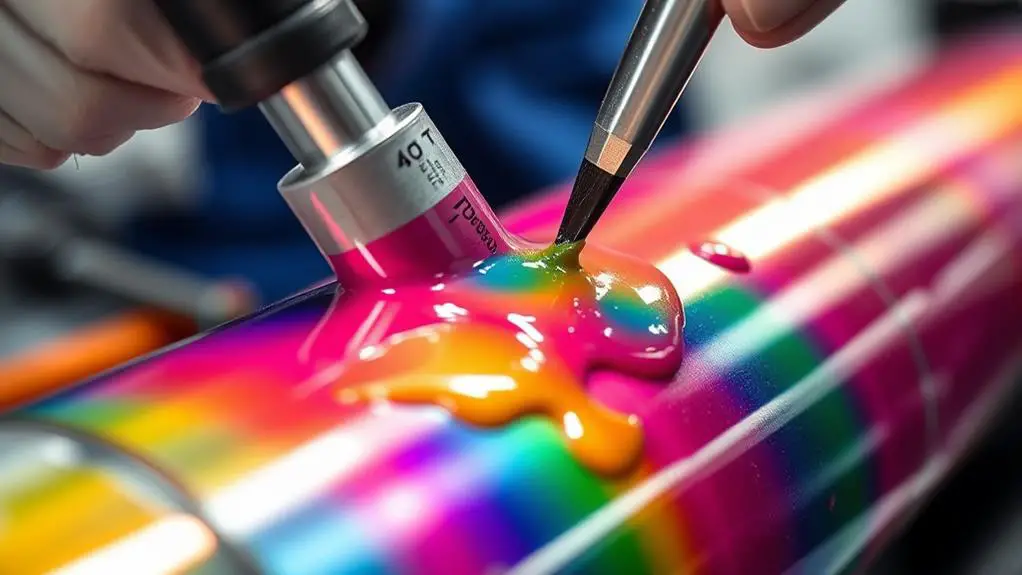To plastic coat metal, start by cleaning and degreasing the surface for strong adhesion. Next, preheat the metal to the required temperature. Then, immerse it in liquid Plastisol for an even coat. After that, bake the coated metal to cure the plastic effectively. Use polyethylene or PVC for optimal corrosion resistance, and consider customizing with colors or textures based on your needs. Finally, allow the coated part to cool before using it. This process not only protects your metal but also enhances its aesthetic appeal. Curious about the best materials and techniques? There's more to explore!
Key Takeaways
- Clean and degrease the metal surface thoroughly to ensure strong adhesion of the plastic coat.
- Select the appropriate plastic type, such as polyethylene or PVC, for optimal corrosion resistance.
- Preheat the metal part to the specified temperature before immersing it in liquid Plastisol for even coating.
- Immerse the preheated metal in the dipping tank for a set duration, then bake to cure the plastic.
- Allow the coated part to cool completely before handling or applying any secondary processes.
Understanding Plastic Coating
Plastic coating is a fantastic way to enhance the durability and appearance of metal surfaces. By applying liquid polymers, like Plastisol, you create a strong layer of protection that improves the metal's properties.
One of the standout features of plastic coatings to metal is their exceptional corrosion resistance. This means your metal surfaces are less likely to rust or degrade over time, even in harsh environments.
The dip coating process is one of the most popular methods for applying these durable coatings. In this method, metal items are immersed in a bath of liquid polymer, ensuring an even coating that adheres well to the surface.
Pre-treatment steps, like cleaning and optional priming, are crucial for achieving strong adhesion, so don't skip them!
Customization is another perk of plastic coatings. You can choose from a variety of colors and textures, and even add specific functionalities like flame retardancy or fungus resistance.
This versatility makes plastic coatings invaluable across various industries, including automotive, medical, construction, and electronics. By understanding these elements, you're well on your way to making informed decisions for your metal coating projects.
Essential Materials Needed
When you decide to plastic coat metal, having the right materials on hand is crucial for achieving the best results.
Here's a quick list of essentials you'll need to get started:
- Plastic Type: Choose between polyethylene or PVC for optimal resistance to corrosion and durability.
- Dipping Tank: A container for your liquid Plastisol, ensuring the metal components are fully submerged for an even coating.
- Preheat Oven: Necessary for heating your metal parts to the appropriate temperature before immersion, affecting the thickness and adhesion of the plastic coating.
- Cleaners and Degreasers: Critical for pretreatment, these products remove surface impurities, enhancing the bond between the plastic and metal.
With these materials, you'll set the stage for a successful plastic coating process.
Consider optional additives to customize your Plastisol for specific needs, like improving dielectric strength or adding flame retardancy.
Mixing the Plastic Coat
To achieve a smooth and effective plastic coat, you'll need to carefully mix your materials.
Start by breaking white Polystyrene or Styrofoam into smaller pieces and placing them in an airtight jar. This will help facilitate the mixing process with a clear solvent, like Tetrahydrofuran or Acetone.
Begin adding the solvent to the jar. You'll notice that the Polystyrene starts to dissolve almost immediately. Keep adding Polystyrene until the mixture reaches a thick consistency, which indicates that most of the material has dissolved. This thickness is crucial for achieving a durable plastic coating.
If, after overnight mixing, you still see undissolved Polystyrene, don't worry. Just use a paint filter to remove any solids, ensuring a smoother application.
Application Techniques
Achieving a successful plastic coat on metal involves several key application techniques that can significantly enhance the durability and appearance of your project.
First, you'll want to pre-treat the metal surface by thoroughly cleaning and degreasing it. This ensures a strong adhesion of the plastic coat.
Next, preheating the metal part to the specified temperature is crucial for achieving the desired coating thickness during the dipping process.
Once ready, immerse the preheated metal part in liquid Plastisol for a predetermined duration to build that perfect layer of plastic coating.
After immersion, bake the coated part at the required temperature according to the formula to cure the plastic, which enhances its durability.
Finally, allow the coated part to cool down before proceeding with any secondary processes. This helps maintain the integrity of the coating.
Here's a quick overview of the application techniques you'll use:
- Clean and degrease the metal surface.
- Preheat the metal to the specified temperature.
- Dip the part in liquid Plastisol.
- Bake to cure and cool before finishing touches.
Following these steps ensures your metal coating is both functional and visually appealing!
Benefits and Considerations
Plastic coating metal not only improves its appearance but also brings a host of benefits that make it a smart choice for various applications. By using plastic coatings, like polyvinyl chloride (PVC), you gain excellent corrosion resistance, ensuring metal surfaces remain rust-free and last longer in different environments. Additionally, these coatings enhance the visual quality with customizable colors and finishes that can match your design preferences.
Here's a quick overview of the benefits and considerations:
| Benefit/Consideration | Description | Key Materials |
|---|---|---|
| Corrosion Resistance | Protects against rust, extending lifespan. | PVC, Polyethylene |
| Aesthetic Appeal | Customizable colors and finishes for visual impact. | PVC |
| Durability and Resistance | Withstands chemicals; ideal for harsh environments. | PVC, Polyethylene |
| Easy Maintenance | Smooth surface simplifies cleaning and hygiene. | PVC |
Consider your specific application needs, as different plastic types offer unique advantages. With the right choice, you'll enjoy the long-term usability and enhanced functionality of your metal parts.
Frequently Asked Questions
How Do You Seal Metal to Plastic?
To seal metal to plastic, clean both surfaces thoroughly, then apply a strong adhesive like epoxy. You might want to use a primer on the plastic for better adhesion, and let it cure properly.
What Plastic Is Used to Coat Metal?
You'll find various plastics used to coat metal, like polyethylene for corrosion resistance, PVC for moisture barriers, PTFE for non-stick surfaces, and polyurethane for durability. Each offers unique benefits tailored to specific needs.
How Do You Bond Metal to Plastic?
To bond metal to plastic, start by cleaning and preparing both surfaces. Then, use epoxy or specialized adhesives for a strong hold. Consider mechanical fasteners for added support, ensuring both materials are compatible for durability.
How to Rubber Coat Metal at Home?
To rubber coat metal at home, start by cleaning the surface. Preheat it, then immerse in liquid rubber. Bake to cure, let it cool, and consider a second coat for extra protection. You've got this!

